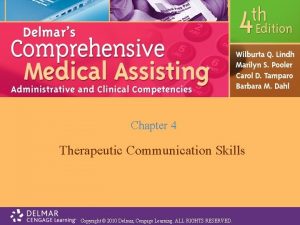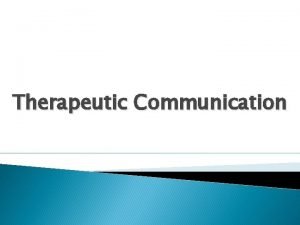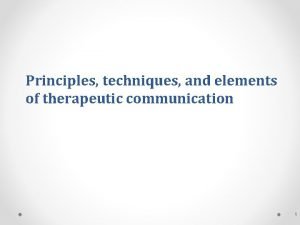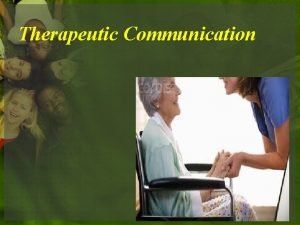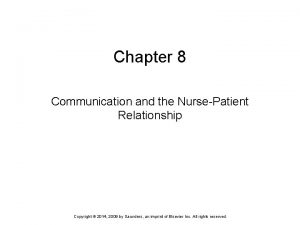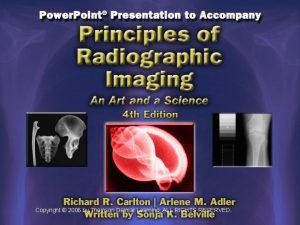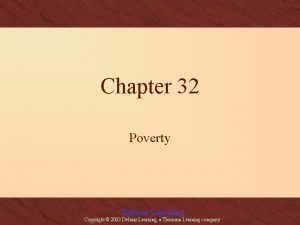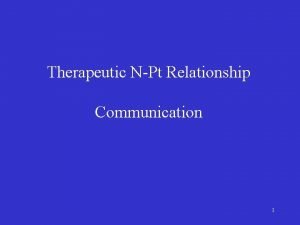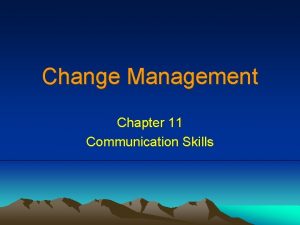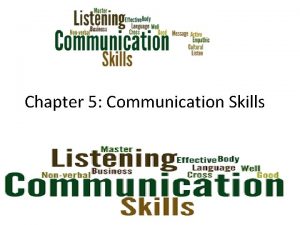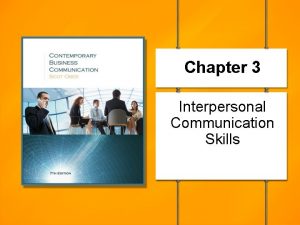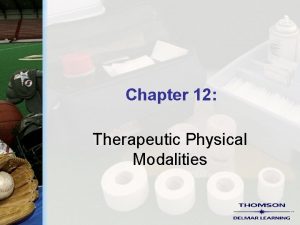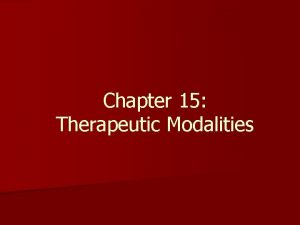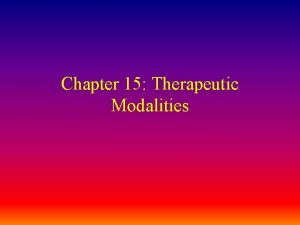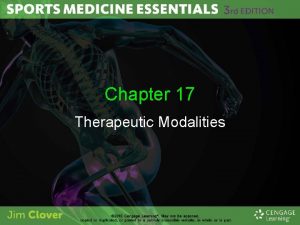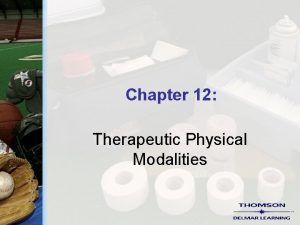Chapter 4 Therapeutic Communication Skills Copyright 2010 Delmar


































- Slides: 34

Chapter 4 Therapeutic Communication Skills Copyright © 2010 Delmar, Cengage Learning. ALL RIGHTS RESERVED.

Importance of Communication • Foundation for all patient care • Therapeutic communication skills create feelings of comfort for patients Copyright © 2010 Delmar, Cengage Learning. ALL RIGHTS RESERVED.

The Communication Cycle • Involves two or more individuals exchanging information • Involves sending and receiving messages Copyright © 2010 Delmar, Cengage Learning. ALL RIGHTS RESERVED.

The Communication Cycle ^^ The communication cycle and channels of communication. Copyright © 2010 Delmar, Cengage Learning. ALL RIGHTS RESERVED.

Four Elements of the Communication Cycle • The sender begins cycle by encoding message • The message delivered via a channel or mode of communication • • Speaking Listening Gestures or body language Writing Copyright © 2010 Delmar, Cengage Learning. ALL RIGHTS RESERVED.

Four Elements of the Communication Cycle • The receiver must decode the meaning of the message • Feedback takes place after receiver has decoded message sent by sender Copyright © 2010 Delmar, Cengage Learning. ALL RIGHTS RESERVED.

The Communication Cycle • Listening skills – Active listening involves verifying message from sender – Received message is sent back to sender worded slightly differently Copyright © 2010 Delmar, Cengage Learning. ALL RIGHTS RESERVED.

Verbal Communication • Takes place when message is spoken • Sender and receiver must apply same meaning to spoken words Copyright © 2010 Delmar, Cengage Learning. ALL RIGHTS RESERVED.

Verbal Communication • The Five C’s of Communication: – Complete – Clear • • Eye contact enhances clarity Articulate and enunciate Time to process message Message must be heard – Concise – Cohesive – Courteous Copyright © 2010 Delmar, Cengage Learning. ALL RIGHTS RESERVED.

Verbal Communication • Good communication skills help establish rapport with patients – Call patients by full name – Encourage patients to verbalize feelings – Give technical information to patients clearly • Allow patients to make practical application to their health needs Copyright © 2010 Delmar, Cengage Learning. ALL RIGHTS RESERVED.

Nonverbal Communication • Body language – Unconscious body movements, gestures, and facial expressions Body language can communicate more than spoken words >> Copyright © 2010 Delmar, Cengage Learning. ALL RIGHTS RESERVED.

Nonverbal Communication • Body Language – – Expressions that accompany speech Kinesics is study of body language Body language learned first Body language influenced by primary caregivers and culture Copyright © 2010 Delmar, Cengage Learning. ALL RIGHTS RESERVED.

Nonverbal Communication • Feelings and emotions are communicated through nonverbal means – 70% of language is nonverbal – Tone of voice communicates 23% of message – Spoken word communicates 7% of message Copyright © 2010 Delmar, Cengage Learning. ALL RIGHTS RESERVED.

Nonverbal Communication • Facial expression – Eyes reflect feelings – Staring is invasion of privacy – Cultural influences affect facial expressions • Personal space – Comfortable personal space – Handled differently by various cultures – Explain procedures that will be invasive Copyright © 2010 Delmar, Cengage Learning. ALL RIGHTS RESERVED.

Nonverbal Communication • Posture – Relates to position of body or parts of body – Involves at least half the body • Position – Face-to-face communication – Should enable observation of verbal and nonverbal cues Copyright © 2010 Delmar, Cengage Learning. ALL RIGHTS RESERVED.

Nonverbal Communication Positive posture and position encourage therapeutic communication >> Copyright © 2010 Delmar, Cengage Learning. ALL RIGHTS RESERVED.

Nonverbal Communication • Gestures and mannerisms – “Talk” with hands – Enhances spoken word • Touch – Appropriate touch is therapeutic – Not all patients are comfortable with touch Copyright © 2010 Delmar, Cengage Learning. ALL RIGHTS RESERVED.

Congruency in Communication Click Here to play the video Copyright © 2010 Delmar, Cengage Learning. ALL RIGHTS RESERVED.

Congruency in Communication • • Verbal and nonverbal messages must agree The meaning of mixed messages Clustering groups of nonverbal messages Masking conceals true feeling or message Copyright © 2010 Delmar, Cengage Learning. ALL RIGHTS RESERVED.

Congruency in Communication • Perception – Conscious awareness of one’s own feelings and the feelings of others – Sense another’s attitudes, moods, and feelings – Follow perceived assessments with verbal validation – Easily misinterpreted Copyright © 2010 Delmar, Cengage Learning. ALL RIGHTS RESERVED.

Barriers to Therapeutic Communication • Age and gender barriers • Economic barriers • Education and life experience barriers Copyright © 2010 Delmar, Cengage Learning. ALL RIGHTS RESERVED.

Barriers to Therapeutic Communication • Bias and prejudice barriers • Verbal roadblocks to therapeutic communication Copyright © 2010 Delmar, Cengage Learning. ALL RIGHTS RESERVED.

Defense Mechanisms as Barriers • • • Regression Denial Repression Projection Sublimation • • Displacement Compensation Rationalization Undoing Copyright © 2010 Delmar, Cengage Learning. ALL RIGHTS RESERVED.

Barriers to Therapeutic Communication • Barriers caused by cultural and religious diversity – Caregiving expectations – Time focus Copyright © 2010 Delmar, Cengage Learning. ALL RIGHTS RESERVED.

Barriers to Therapeutic Communication • Human needs as barriers to communication Maslow’s hierarchy of needs >> Copyright © 2010 Delmar, Cengage Learning. ALL RIGHTS RESERVED.

Establishing Multicultural Communication • The patient must trust the professional • Steps to building trust include: – – – Risk/trust Conveying empathy Showing respect Being genuine Active listening Copyright © 2010 Delmar, Cengage Learning. ALL RIGHTS RESERVED.

Working with Multicultural and Diverse Patient Populations Click Here to play the video Copyright © 2010 Delmar, Cengage Learning. ALL RIGHTS RESERVED.

Cultural Brokering • Cultural broker serves as a go-between • One who advocates on behalf of another individual or group within the health care community Copyright © 2010 Delmar, Cengage Learning. ALL RIGHTS RESERVED.

Cultural Brokering • Goal of cultural brokering – Increase the capacity of health care and mental health programs to design, implement, and evaluate culturally and linguistically competent service delivery systems • Cultural brokers may assume the role of medical interpreter Copyright © 2010 Delmar, Cengage Learning. ALL RIGHTS RESERVED.

Working with Interpreters • Interpreters do not provide word-for-word equivalence, rather focus on the accurate expression of equivalent meaning • Remember to speak directly to the patient, not to the interpreter Copyright © 2010 Delmar, Cengage Learning. ALL RIGHTS RESERVED.

Working with Interpreters • A family member may serve as the interpreter • Disadvantage of a family member serving as interpreter – They may not understand medical terminology – It would be very difficult for a family member to share a poor prognosis or a life-threatening diagnosis Copyright © 2010 Delmar, Cengage Learning. ALL RIGHTS RESERVED.

Interview Techniques • Closed questions – “Are you taking your medications? ” • Open-ended questions – “How are you coming along with your diet? ” • Indirect statements – “Tell me what you’ve been doing since your retirement. ” Copyright © 2010 Delmar, Cengage Learning. ALL RIGHTS RESERVED.

Point of Care Techniques • Location where the patient and provider or patient and office personnel physically interact Copyright © 2010 Delmar, Cengage Learning. ALL RIGHTS RESERVED.

Community Resources • Need to refer patient to a community resource • Developing a community resource document Copyright © 2010 Delmar, Cengage Learning. ALL RIGHTS RESERVED.
 Chapter 4 therapeutic communication skills
Chapter 4 therapeutic communication skills Multicultural therapeutic communication skills
Multicultural therapeutic communication skills Copyright 2010 pearson education inc
Copyright 2010 pearson education inc C-929-a
C-929-a Variazioni finanziarie positive e negative
Variazioni finanziarie positive e negative Copyright 2010 pearson education inc
Copyright 2010 pearson education inc Copyright 2010 pearson education inc
Copyright 2010 pearson education inc Copyright 2010
Copyright 2010 Nwoz
Nwoz Copyright 2010 pearson education inc
Copyright 2010 pearson education inc Copyright 2010 pearson education inc
Copyright 2010 pearson education inc Copyright 2010 pearson education inc
Copyright 2010 pearson education inc 2010 pearson education inc
2010 pearson education inc Copyright 2010 pearson education inc
Copyright 2010 pearson education inc Copyright 2010 pearson education inc
Copyright 2010 pearson education inc Copyright 2010 pearson education inc
Copyright 2010 pearson education inc Introduction of therapeutic communication
Introduction of therapeutic communication Techniques of therapeutic communication
Techniques of therapeutic communication Komunikasi non terapeutik
Komunikasi non terapeutik Goals of therapeutic communication
Goals of therapeutic communication Pre-hospital communication
Pre-hospital communication Therapeutic communication techniques
Therapeutic communication techniques 2009 delmar cengage learning
2009 delmar cengage learning 2009 delmar cengage learning
2009 delmar cengage learning Medical terminology chapter 1 learning exercises answers
Medical terminology chapter 1 learning exercises answers Graphing tpr
Graphing tpr Delmar isotonic
Delmar isotonic Delmar tsi
Delmar tsi Delmar customs broker
Delmar customs broker Delmar thomson learning
Delmar thomson learning Chapter 6 skeletal system
Chapter 6 skeletal system 2009 delmar cengage learning
2009 delmar cengage learning Chapter 10 cultural diversity
Chapter 10 cultural diversity Delmar larsen
Delmar larsen Delmar cengage learning instructor resources
Delmar cengage learning instructor resources
